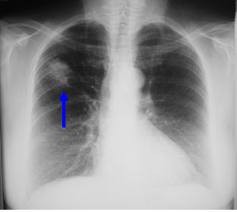
Lung Cancer in Women
by NetCrunch
Incidence of lung cancer is increasing in women. This article discusses the issue.
Introduction
Cancer is a disease in which the affected cells proliferate without control in an organ or tissue to form a tumor. Lung cancer is defined by the presence of a tumor that develops in the lung tissue. The tumour usually goes unnoticed for some time (because there are no specific symptoms until advanced stages), so it is virtually impossible to detect it early. Women are being increasingly affected by lung cancer.
 |
Incidence of Lung Cancer in Women
During the past twenty years, incidence of lung cancer has risen sharply, especially among women. We know that lung cancer is closely linked to smoking. The increase of lung cancer in women may partly be attributed to the fact that smoking has increased among women during the last forty years. In addition, one quarter of deaths occur before age 65. Indeed, most smokers started smoking while they were still quite young, unaware of the fact that smoking is so injurious to health.
Several studies have also shown that women are more susceptible to lung cancer than men. In fact, proportionately and without smoking, the number of lung cancer in women is higher than in men. The carcinogenic risk of tobacco is higher in women compared to men. One of the hypotheses is hormonal influence (trials are ongoing). Several other factors may also influence lung cancer in women such as: genetic predisposition, environment, diet, family history or occupational exposures
Screening for lung cancer
The diagnosis of lung cancer is usually done by chest radiograph at first. It can then show a dark spot and irregular, a veil, or a pleural effusion. A CT scan will be prescribed a second time to find smaller lesions and to examine areas invisible on radiographs. Then a third time, a bronchoscopy will be performed to examine the bronchial tubes (using a mini-camera) and a piece of the tumour will be taken for biopsy to ascertain whether it’s malignant or not.
However, no early detection is organized (like it is done for breast cancer, for example) at the moment. Several factors are involved. The first factor is the cost associated with these types of screening. The second is that there is a risk of false positive, and also false negative, making these exams disturbing for some, and falsely reassuring for others. In addition, this screening allows for the most part, longer "artificial” life (the cancer is discovered early, but the outcome of risk remains same.). In addition, some cancers may be found indolent (it is difficult to distinguish a benign from a malignant tumor with an X-ray or CT scan).
In general, screening is done at a late stage. Women visit physicians after various clinical signs: cough, dyspnea, coughing blood, breathlessness, chest pain, recurrent pulmonary infections. The average age of discovery is around 50-60 years, although the average age is decreasing more and more. About 90% of lung cancers are diagnosed in women who are smokers.
Support
Indeed, a woman who has undergone chemotherapy has a high risk of losing her hair. Men also lose their hair, but they are generally more accepting of their self image than women. In recent years, it is getting more and more easier for women to get wigs, care by socio-beautician or relaxation sessions (reflexology, relaxation therapy, for example). This care and comfort have a vital role in the management of cancer in women.
The management of lung cancer in women will depend on several factors. First, stage of disease. Indeed, the management of cancer diagnosed early will not be the same as for cancer at a more advanced stage. The treatment may have different objectives. It can allow either to eliminate the tumour completely in order to heal the patient and reduce the risk of recurrence or try to prevent the spread of cancer and improve the quality of life. The choice of treatment (surgery, chemotherapy, radiotherapy ...) will determine the type of care.
The management of cancer in women includes several areas. There are of course all the medical side, support by caregivers and emotional support through associations, or psychologist. But also, there should be assistance for her for the acceptance of her new body image.
You might also like
What is Fibromyalgia and What Causes FibromyalgiaThe pain and emotional agony of fibromyalgia has stricken many American women...
Why am I Always Cold?Have you wondered this, too? I am sick and tired of the men in my life tellin...





 How to Stop Procrastinatingon 06/21/2011
How to Stop Procrastinatingon 06/21/2011
 Rila Monasteryon 06/03/2011
Rila Monasteryon 06/03/2011


Comments
Cancer affects so many people and is so devastating. Nice overview of lung cancer in women.